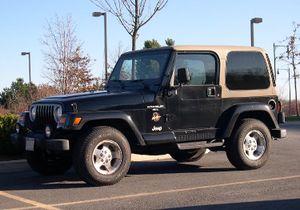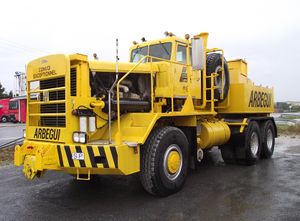دفع كلي

الدفع الكلي المستمر أو الدفع الرباعي المستمر All-wheel drive (اختصاراً AWD)، نوع من أنظمة دفع السيارات لنقل الحركة من المحرك إلى العجلات الخلفية والأمامية للسيارة، وهو أحد الأنواع الأربعة للدفع، أما النوعان الأخران هما: جر أمامي دفع خلفي و الدفع الرباعي 4X4 .[1][2]
وهو ينقسم إلى قسمين: الدفرنس وهو التعليق الصلب ويستخدم للشاحنات وسيارات النقل نظرا لصلابته والنوع الاخر هو الفريول (نظام التعليق المستقل) والذي يستخدم في السيارات الفاخرة مثل المرسيدس و بي إم دبليو واللكزس وهو مريح لانة حر الحركة علي سبيل المثال حين تعرض الإطار الخلفي الأيمن لمطب او حفرة او ماشابة فإنة لايؤثر بالحركة بشكل كبير على الجهة اليسرى. وبدأت شركة فورد باستخدام الفريول في سيارتها العائلية الضخمة اكسبدشن وايضاً شقيقتها الصغرى اكسبلورر. وهو يستخدم من قبل دودج و جيب و كرايسلر في جميع الفئات ماعدا ( دودج رام - جيب رانجلر )>
جيب رانجلر تستخدم دفع رباعي 4X4 عن طريق غيار الفتيس,
بينما الدفع المستمر AWD كما في سوبارو لا يحتاج لأي تدخل من السائق
استخدام المصطلح
Particularly in North America for several decades, the designation AWD has been used and marketed - distinctly from "4X4" and "4WD" - to apply to vehicles with drive train systems that have permanent drive, a differential between the front and rear drive shafts, and active management of torque transfer, especially following the advent of ABS. However, the designations AWD[3] and all-wheel drive[4] long predated the trend, with Associated Equipment Company (AEC) building AWD trucks in conjunction with FWD (UK) in 1929, and General Motors manufacturing a line as "all-wheel drive" as early as the late 1930s. This distinction in terminology is not generally used outside North America.
الخصائص
When tire grip is good during road driving, a differential is used between the axles to avoid driveline windup. This is not required off-road, as the limited grip allows the tires to slip. All-wheel drive vehicles designed for extensive off-road use may not have such a differential, and so they suffer from wind-up when used on-road.[5] Selectable 4WD also avoids this problem and requires only a simple dog clutch in the transfer case, rather than a differential. For this reason, most early off-road vehicles used that system; e.g., Jeep, Land Rover.
As vehicles became more sophisticated and tires gave better winter performance in the 1960s there was an interest in giving the benefits of all-wheel drive to conventional cars; not for off-road use but for winter use in snow or on wet roads. Exotic vehicles such as the high-powered Jensen FF followed by the AMC Eagle, Subaru Leone and Audi Quattro series were the first to offer all-wheel drive in a high-speed road-based car. These, particularly the Quattro, would extensively develop this drivetrain with the use of viscous couplings and differentials to provide a safe and drivable car. The first off-road / on-road hybrids such as the Range Rover also chose the permanent all wheel drive system rather than manual selection.
Selectable 4WD has both axles rigidly coupled together, which has some advantages in very poor off-road conditions. To gain the same advantage in a permanent AWD system with a differential, the differential can be locked manually with a differential lock. As this control is frequently misunderstood and mis-used, which can then cause damage due to wind-up, they have tended to be replaced by automatic locking through the viscous couplers.
العيوب
- ضعف عزم السيارة، لأن بعض قوة المحرك تضيع إلى أن تصل إلى قوة الدفع (الإطارات الخلفية)، وحالياً يتم تفادي هذه المشكلة مع زيادة قوة المحركات.
- ثقل السيارة.
- تستهلك كميات وقود أكثر من سيارات الدفع الأمامي.
- التروس الفرقية (الدفرنشل) غير مريح و غير ثابت مقارنةً بالدفع الامامي والرباعي.
المميزات
- صيانته أقل و أرخص.
- الثبات في الخطوط و الطرق الطويلة، نظراً لثقل السيارة.
- أفضل تحملاً للبيئة الصحراوية، و أفضل في الرمال مقارنة مع الدفع الأمامي.
- يعتبرر الدفع الرباعي (التعليق المستقل)، أكثر راحة وثبات.
- يعطي قوة دفع أكبر للسيارة
انظر أيضاً
- دفع أمامي
- دفع خلفي
- All-terrain vehicle
- Two-wheel drive
- H-drive
- Four Wheel Drive or FWD, one of the first companies, from 1909, to build four-wheel drive vehicles.
المصادر
- ^ [1]"1929: AEC started to build AWD trucks in conjunction with FWD (UK)" Archived 2018-06-13 at the Wayback Machine
- ^ In National Service.
{{cite book}}: Cite has empty unknown parameters:|lay-date=,|subscription=,|nopp=,|last-author-amp=,|name-list-format=,|lay-source=,|registration=, and|lay-summary=(help) - ^ Allisons.org Automotive History [2]"1929: AEC started to build AWD trucks in conjunction with FWD (UK)"
- ^ MEYER, DONALD E. THE FIRST CENTURY OF GMC TRUCK HISTORY [3] "By December [1939], GMC had orders for more than 4,400 all-wheel-drive military trucks."
- ^ Ware, Pat (1994). In National Service. Warehouse Publications. p. 118. ISBN 0-9525563-0-8.
{{cite book}}: Invalid|ref=harv(help)

